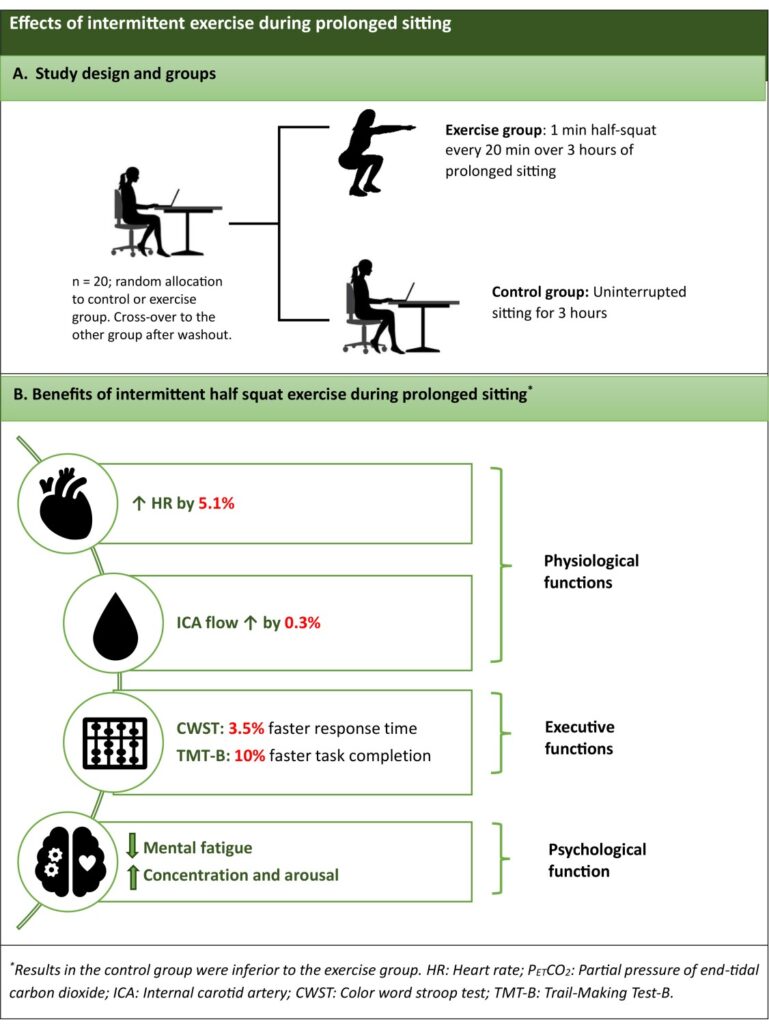
Prolonged sitting, one of the most prevalent forms of chronic sedentary behavior, is often associated with mild impairment of cognitive functions. Acute bouts of uninterrupted prolonged sitting decrease blood flow to cerebral tissues, thus impairing executive functions. A recent study by Horiuchi et al. investigated the effect of intermittent half-squat exercises on executive functions during prolonged sitting. The study reported that half-squat interruptions could improve executive function by increasing blood flow in the internal carotid artery (major blood vessel that supply blood to the brain) and maintaining mental arousal and concentration.
This randomized controlled crossover trial enrolled 20 participants (age range: 21 ± 1 years; 9 women; BMI 21.6 ± 1.6 kg/m2). The study participants were divided into two groups (Graphic A):
1. Control (CON) group: prolonged sitting for 3 hours without any interruptions
2. Exercise (EX) group: sitting for 3 hours with 1 minute of half-squats every 20 minutes
Cardiorespiratory variables like mean arterial pressure (MAP), heart rate (HR), and partial pressure of end-tidal carbon dioxide (PETCO2), and internal carotid artery (ICA) blood flow were determined in the sitting positions at various time intervals (10, 60, 120, and 180 minutes). Executive function was evaluated using the Color Word Stroop Test (CWST) and Trail-Making Test-B (TMT-B) before and after the sitting period. Subjective feelings of mental arousal, mental fatigue, concentration, and motivation were also evaluated using a Visual Analog Scale (VAS) before and after the sitting period.
The results of the trial are summarized below:
1. There was no significant difference in MAP between the two groups. However, there was a significant interaction effect for heart rate (HR; p = 0.074) with an average increase of 5.1% in the EX group and 8.7% in the CON group (Graphic B).
2. PETCO2 dropped from 0 to 180 min both, in the CON and EX groups.
3. In the CON group, ICA flow decreased by 3.7%, while in the EX group, the flow increased by 0.3% (Graphic B).
4. Over the 3 hours of sitting period, correct reaction times with the incongruent CWST showed a significant interaction effect (p <0.01) with the EX group being 3.5% faster in their response times and the CON group being 4.2% slower. TMT-B completion speed also showed a significant interaction effect (p <0.01), with the EX group completing the task 10% faster and the CON group being 8.8% slower in completing the tasks (Graphic B).
5. Intermittent exercise also suppressed mental fatigue, with a significant interaction effect (285% vs. 157% for CON vs. EX, p <0.04).
6. There was a significant improvement in concentration in the EX group (–28.7% vs. –9.2% for CON vs. EX, p = 0.048).

Clinical implications
The findings of this study suggested that a simple strategy like intermittent squat exercises could help in maintaining executive function during prolonged sitting, possibly through preservation of the ICA blood flow, which may help maintain mental arousal and concentration. Half-squat intervention seems to be beneficial in people with sedentary work life. It will help them to break from prolonged sitting period and preserve cognition.
(Reference: Horiuchi M, Pomeroy A, Horiuchi Y, Stone K, Stoner L. Effects of intermittent exercise during prolonged sitting on executive function, cerebrovascular and psychological response: A randomized cross-over trial. J Appl Physiol (1985). 2023. Doi: 10.1152/japplphysiol.00437.2023)
